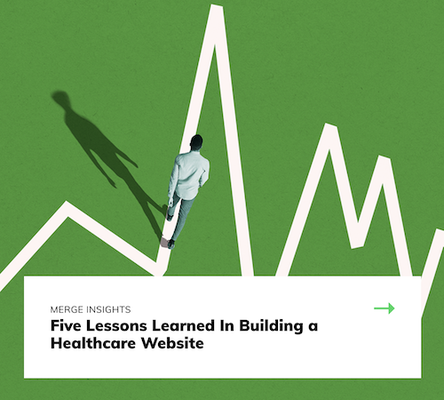
With decades of experience working with healthcare organizations, MERGE offers up important lessons for those looking to build a robust healthcare website.
Since its inception, MERGE has been privileged to work with a broad range of healthcare organizations. With experts on hand in fields of academic medical research, not to mention decades of combined experience working in IT and marketing departments of healthcare systems, we’ve immersed ourselves in the challenges and opportunities that working in healthcare presents and have made it our mission to help transform and modernize healthcare marketing technology practices for our clients.
While each organization is different and technology has changed dramatically over time, certain themes have persisted, offering a roadmap to success for web and digital endeavors in healthcare. The following “lessons” are from our experience working with multitudes of healthcare provider organizations.
Lesson 1: Understanding the nuances of healthcare organizations and the metrics that drive success in healthcare are foundational in planning your digital ecosystem.
Healthcare systems are big! Not just in employee headcount and service areas, but in complexity and variety of needs. Like most large organizations, healthcare systems are challenged with servicing a diverse population of consumers while also balancing the need to recruit and retain quality employees, often relying on marketing as the central driver of the overall brand and digital strategy to meet these challenges. However, the complexity grows in healthcare once we start to look at the variety of service offerings within.
For example, it is typical for most health systems to have:
Developing an approach that leverages enterprise tools can ensure your organization is presenting the brand as a unified voice, while still allowing for the flexibility to cater to each unique patient subset.
Lesson 2: Meeting the consumer where they are at and not challenging them to “think like us” is critical in creating valuable user experiences.
Consumer expectations vs. satisfaction. This is both the driving force behind good UX and one of the hardest metrics to measure. Understanding the gap between our current consumer UX and the expectations of our users is key to true improvement. Modern healthcare consumers live in a digital world where you can schedule a haircut online, order your groceries for pickup, and even rent a truck without ever interacting with a live person.
These experiences carry through to consumers’ expectations of features and functionality of our healthcare website, yet the delivery often lacks. A robust Digital Experience Platform (DXP) can act as the central hub of your evolving digital transformation. With built-in A/B testing and AI driven analysis, DXPs have the ability to help us quantify the value of interactions and determine if changes to the site are truly improving experiences.
Lesson 3: In healthcare, nothing is more important than security and privacy.
This “lesson” practically stands alone. Security and privacy is of utmost importance in healthcare for a few reasons:
Working with a healthcare expert provides the right combination of technical infrastructure and healthcare security/privacy expertise to allow your organization to safely move towards these advanced tactics and strategies.
Lesson 4: For our clients’ marketing teams, automation and a well orchestrated technology stack is the difference between a “small, but mighty” team and an “overtaxed and exhausted” team.
Healthcare marketing teams are typically smaller in headcount and tasked with a broader scope of responsibilities than other industries. This fact makes it extremely important to leverage automation and a modern technical stack as a way of improving efficiency and reducing human error.
An enterprise DXP is fundamental to producing an administrative workflow that helps to meet this lofty goal. However, like any DXP, it can be configured to be the stuff that dreams are made of, or pure nightmare fuel. Ultimately, it depends on the way the platform is planned, configured and executed.
Lesson 5: A strategy and approach based on quantifiable outcomes is the only way to measure success in a world where online transactions are not “sales” and direct revenue is difficult to attribute.
You can’t improve what you don’t measure. Similarly, if you don’t plan, you can’t measure. The development of a measurement strategy in the early phases of any initiative is key and the implementation of the website on a DXP that allows for robust and secure reporting is essential as well. Ensuring both the strategy and the platform are aligned can mean the difference between a measurable success and a mysterious outcome.
Digital marketing in healthcare presents a specific challenge compared to other industries, but by leveraging DXPs, we can empower our lean and nimble marketing teams to not only contribute to the growth and success of the organization, but allow them to play a role in the overall health of our communities and the positive outcome of our patients.
Keir Bradshaw
EVP, Technology
The original version of this page was published at: https://mergeworld.com/insights/merge-insights/five-lessons-learned-in-building-a-healthcare-website
We are an award-winning marketing services firm that merges storytelling and technology to bring health, wealth and happiness to the world. People come to MERGE looking for a new way; for ideas and... Read more
Any marketer whose career started before 1997 knows all too well about the traditional marketing funnel. We were trained on it, we followed it and oftentimes worshipped it. The funnel ...read more
Part I of MERGE’s seven-part series on omnichannel marketing takes a look at what omnichannel is, how we define it and offers a preview of the critical components for building ...read more
With the threat of COVID-19 looming, NASCAR made an unprecedented decision to cancel three races and replace them with the first-ever eNASCAR iRacing Pro Invitational Series. The innovative ...read more
Part Three of MERGE’s seven-part series on omnichannel marketing underscores the importance of understanding your audience, what matters to them, and the art of meeting them ...read more